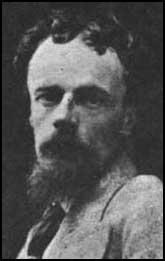John Atkinson Grimshaw

John Atkinson Grimshaw was born in Leeds in 1836. His father was a policeman but in 1848 he found work with the Great Northern Railway Company. Grimshaw's parents were strict Baptists and his mother strongly disapproved of his interest in painting and on one occasion she destroyed all his paints.
In 1852 Grimshaw became a clerk at the Great Northern Railway office in Leeds. The city had several art galleries and Grimshaw was able to see the work of Holman Hunt (The Light of the World), Henry Wallis (Death of Chatterton) and William Powell Frith (Derby Day).
Grimshaw decided to become a full-time painter and in 1861 he left his job with the Great Northern Railway. Grimshaw's paintings were sold in two art galleries, smaller picture dealers and a couple of bookshops in Leeds. One of his main customers was Thomas Fenteman, who owned an antiquarian booksellers. Fenteman was a deeply religious man and would only buy the pictures after Grimshaw had confirmed that they had not been painted on a Sunday.
Grimshaw became a popular artist in Leeds and in 1865 he was able to move with his wife to a more expensive part of the city. William Agnew, a London art dealer, began purchasing his work. Further success came when a picture by Grimshaw was accepted by the Royal Academy. By 1870 Grimshaw was in a position to buy Knostrop Old Hall, a large seventeenth-century manor house, two miles from Leeds. Fanny Grimshaw gave birth to fifteen children but only six reached adulthood.
Until the early 1870s Grimshaw's paintings were predominantly still lifes with a few landscapes of the Leeds area. However, he gradually became interested in painting night scenes. This included Liverpool from Wapping (1875), Nightfall down the Thames (1880), Shipping on the Clyde (1881), Park Row, Leeds (1882), The Thames by Moonlight (1884), Liverpool Quay by Moonlight(1887) and Prince's Dock, Hull (1887). These paintings often included the smoke pollution and damp fogs that were common in industrial cities in the late 19th century.
Grimshaw had campaigned for a Leeds City Art Gallery since it was first suggested by Edmund Bates in 1862, and after a long struggle it was eventually opened in 1888. The Gallery mounted annual spring exhibitions in which Grimshaw was always represented.
John Atkinson Grimshaw died in 31st October 1893.
